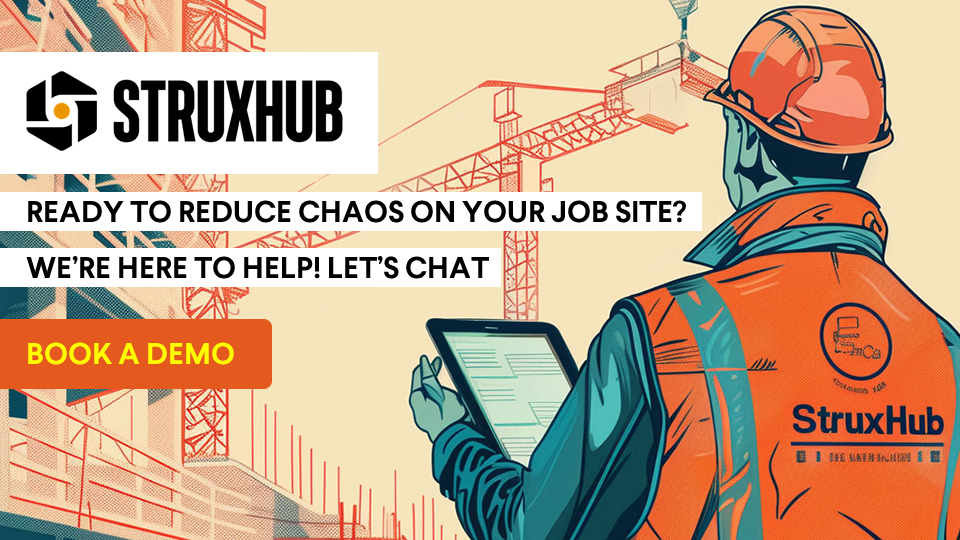Mastering Project Planning in Construction Management Software: Essential Tools and Techniques
Table of Contents:
Imagine sailing without a compass. Terrifying, right? Setting clear objectives in your construction project is akin to having a North Star. It guides every decision and action. But what makes an objective clear?
When it comes to construction management, one phrase stands out like a beacon: “Project Planning.” But, what exactly does it mean to master project planning in the realm of construction management software? Let’s dive into this detailed guide that promises to turn you from a mere user to a virtuoso of construction project planning. Buckle up, because this ride is going to be as enlightening as it is engaging!

The Blueprint: Understanding Project Planning in Construction Management
Before we can talk tools and techniques, let’s lay down the foundation. Project planning in construction management is all about orchestrating a symphony of tasks, timelines, and resources to ensure your project hits all the right notes. It’s the difference between a chaotic construction site and a well-oiled machine. But how do you go from chaos to control? Spoiler alert: it’s all in the software.
Setting Clear Objectives: Your Project’s North Star
- Specific: Vague goals are the enemy. Instead of “build quickly,” aim for “complete foundation by June 15th.”
- Measurable: Quantify your progress. Think “install 100 windows” instead of “install windows.”
- Achievable: Aim high, but within reach. Don’t set your team up for failure with impossible deadlines.
- Relevant: Make sure your goals align with the bigger picture. Every objective should push the project towards completion.
- Time-Bound: Deadlines are your best friend. A goal without a timeline is just a dream.
With clear objectives, you set the stage for success. Everything else—resources, timelines, tools—aligns around these goals.
The Right Tools for the Job: Construction Management Software Essentials
Alright, you’ve got your objectives. Now, let’s talk tools. In the vast toolbox of construction management software, a few stand out as must-haves. These are the Swiss Army knives of project planning—versatile, indispensable, and sometimes, a little too shiny to resist.
Resource Allocation: Putting the Right People in the Right Places
Resource allocation is like a game of chess. Place your pieces wisely, and victory is within reach. Mismanage them, and it’s checkmate. Your software should help you track who’s doing what, where, and when. Here are some key features to look for:
- Gantt Charts: These visual timelines help you map out project phases and see at a glance what’s happening when.
- Resource Scheduling: Allocate labor, equipment, and materials efficiently. Avoid double-booking your star players!
- Real-Time Updates: Keep everyone in the loop with instant updates on resource availability and allocation.
Time Management: Beating the Clock
If time is money, then efficient time management is like finding a winning lottery ticket. Construction management software should help you keep projects on schedule with tools like:
- Task Lists and Milestones: Break down the project into manageable tasks with clear milestones.
- Critical Path Method (CPM): Identify the longest stretch of dependent tasks and ensure they’re completed on time.
- Progress Tracking: Monitor your timeline with regular updates and adjust as necessary.
Consider ABC Builders, who were notorious for running late until they implemented a robust time management system. They cut their average project duration by 20%, simply by better managing their schedules. Who says you can’t beat the clock?
Related Articles:
Techniques That Transform: From Planning to Perfection

Having the right tools is half the battle. Knowing how to use them? That’s where the magic happens. Let’s explore some techniques that can elevate your project planning game from good to legendary.
Agile Methodology: Flexibility in the Face of Change
Agile isn’t just for software developers. In construction, it’s about being flexible and responsive to change. Instead of rigid, step-by-step plans, Agile focuses on iterative progress through small, manageable phases. Here’s how to apply it:
- Sprints: Break the project into short, focused phases. Each sprint ends with a tangible deliverable.
- Scrum Meetings: Regular check-ins to discuss progress, roadblocks, and next steps.
- Retrospectives: After each sprint, review what went well and what could improve. Then, adjust accordingly.
Lean Construction: Efficiency is Key
Lean construction focuses on maximizing value and minimizing waste. This approach, borrowed from manufacturing, can significantly improve project outcomes. Here’s how:
- Value Stream Mapping: Identify all steps in your project and eliminate anything that doesn’t add value.
- Just-In-Time Delivery: Schedule material deliveries to arrive exactly when needed, reducing storage costs and waste.
- Continuous Improvement: Always look for ways to streamline processes and improve efficiency.
Integrated Project Delivery (IPD): Collaboration at Its Best
IPD is all about teamwork. It’s a collaborative approach where all stakeholders—owners, designers, contractors—work together from day one. Here’s why it works:
- Shared Goals: Everyone is on the same page, working towards common objectives.
- Open Communication: Regular meetings and transparent communication prevent misunderstandings.
- Risk and Reward Sharing: All parties share in the project’s risks and rewards, incentivizing success.
Case Study: The Grand Tower Project
To see these techniques in action, consider the Grand Tower Project. Faced with tight deadlines and budget constraints, the team implemented Agile, Lean, and IPD methodologies. The result? The project was completed three months ahead of schedule and 10% under budget. Now, that’s what we call mastering project planning!
Related Articles:
Best Guide to Construction Management Software
The Best Guide to Delivery Management Systems (DMS) for Commercial Construction
Navigating Common Pitfalls: Avoiding the Traps
Even with the best tools and techniques, project planning can go awry. But don’t worry—we’ve got you covered. Here are some common pitfalls and how to avoid them.
Pitfall 1: Scope Creep
Scope creep is the silent project killer. It’s what happens when additional tasks and requirements sneak into your project without proper authorization. To avoid it:
- Clear Objectives: Refer back to your initial objectives. Stick to them.
- Change Management: Have a formal process for handling change requests.
- Regular Reviews: Continuously review project scope and ensure everyone is on the same page.
Pitfall 2: Poor Communication
Communication breakdowns can derail even the best-laid plans. Keep the lines open with these tips:
- Regular Meetings: Hold consistent team meetings to discuss progress and roadblocks.
- Collaborative Tools: Use software with built-in communication tools like chat and discussion boards.
- Transparent Reporting: Ensure everyone has access to the same information.
Pitfall 3: Inaccurate Estimates
Underestimating time or costs can spell disaster. Improve your estimates with:
- Historical Data: Use data from past projects to inform your estimates.
- Expert Input: Consult with experienced team members and stakeholders.
- Contingency Plans: Always include a buffer for unexpected issues.

Embracing Technology: The Future of Project Planning
Technology is transforming construction project planning at a breakneck pace. Staying ahead of the curve means embracing these innovations.
Artificial Intelligence and Machine Learning
AI and machine learning are game-changers. They can analyze vast amounts of data to predict project outcomes, optimize schedules, and identify potential risks before they become problems. Imagine having a crystal ball that tells you exactly where to focus your efforts. That’s the power of AI.
Building Information Modeling (BIM)
BIM is revolutionizing the way we design, build, and manage construction projects. It provides a 3D model of the project, which helps in planning, design, and construction. Here’s why BIM is a must-have:
- Visualization: See the project in 3D before breaking ground.
- Coordination: Improve collaboration among stakeholders.
- Efficiency: Reduce errors and rework by identifying issues early.
Real-World Example: The SkyHigh Development
Consider the SkyHigh Development project, a multi-million-dollar skyscraper in the heart of downtown. The project’s success was largely attributed to its exceptional leadership and cohesive team dynamics. The project leader, Emma, was known for her visionary thinking and exceptional communication skills. She organized weekly meetings, ensured every team member’s voice was heard, and addressed conflicts swiftly. The team, a diverse mix of architects, engineers, and construction workers, was motivated and collaborated seamlessly. Their efforts culminated in the early completion of the skyscraper, under budget and with rave reviews. This is a testament to the power of strong leadership and effective teamwork.
Effective Communication: The Backbone of Project Success

You can have the best tools, techniques, and team, but without effective communication, it’s all for naught. Clear, consistent communication ensures everyone is on the same page and working towards the same goals.
The Art of Communication
Communication in project planning isn’t just about exchanging information; it’s about ensuring understanding. Here are some strategies to enhance communication within your team:
- Regular Updates: Keep everyone informed with daily or weekly updates. Use a combination of meetings, emails, and project management tools.
- Open Channels: Create open channels for communication. Encourage team members to share updates, concerns, and suggestions.
- Feedback Loops: Establish feedback loops to gather input and make improvements. This can be as simple as a suggestion box or as formal as regular review meetings.
Tools for Communication
Modern construction management software comes with a plethora of communication tools designed to streamline interaction and keep everyone on the same page. Look for features such as:
- Instant Messaging: For quick, on-the-go conversations.
- Discussion Boards: For in-depth discussions and brainstorming sessions.
- Video Conferencing: For virtual face-to-face meetings, especially useful for remote teams.
- Document Sharing: For easy access to important documents and files.
Case Study: The Greenfield Project
Take the Greenfield Project, a large-scale eco-friendly housing development. The project faced numerous challenges, including environmental regulations and community opposition. However, the project manager, Jack, implemented a robust communication strategy. He used a combination of instant messaging for quick updates, video conferencing for stakeholder meetings, and discussion boards for team brainstorming. This ensured that everyone was informed, involved, and invested in the project’s success. The result? A smooth, on-time, and within-budget completion, with minimal disputes and maximum satisfaction.
Continuous Improvement: The Key to Long-Term Success
The construction industry is dynamic, with new technologies, regulations, and techniques emerging constantly. To stay ahead, you must embrace continuous improvement. This means regularly reviewing your processes, learning from mistakes, and always looking for ways to do better.
The Kaizen Approach
Kaizen, a Japanese term meaning “continuous improvement,” is a philosophy that can transform your project planning. It involves making small, incremental changes that lead to significant improvements over time. Here’s how to implement Kaizen in your project planning:
- Regular Reviews: Conduct regular reviews of your processes and performance. Identify areas for improvement and implement changes.
- Employee Involvement: Encourage team members to contribute ideas for improvement. Often, those on the front lines have the best insights.
- Data-Driven Decisions: Use data to guide your improvement efforts. Track metrics such as project timelines, budgets, and resource utilization.
Learning from Mistakes
Mistakes are inevitable, but they can be valuable learning opportunities. When something goes wrong, analyze what happened, why it happened, and how it can be prevented in the future. This approach not only improves your current project but also enhances your long-term project planning capabilities.
Case Study: The Riverside Redevelopment
Consider the Riverside Redevelopment, a project that initially faced significant delays and cost overruns. The project team adopted the Kaizen approach, conducting regular reviews and soliciting feedback from all stakeholders. They identified inefficiencies in their processes, such as poor resource allocation and communication gaps. By making small, incremental changes, they gradually improved their performance. Over time, they reduced delays, controlled costs, and completed the project successfully. This demonstrates the power of continuous improvement in achieving long-term success.
Related Articles:
Mastering Delivery Scheduling in Construction: Best Techniques and Tools for Materials Deliveries
Mastering Bid Management in Construction: Essential Tools and Best Practices for Winning Projects

StruxHub
Discover how StruxHub can revolutionize your construction management. Contact us today!
Mastering Project Planning for Future Success
Mastering project planning in construction management is no small feat, but with the right tools, techniques, and mindset, it’s entirely achievable. By setting clear objectives, allocating resources wisely, managing time efficiently, and continuously improving your processes, you can transform your projects from chaotic to controlled, from delayed to on-time, and from over-budget to within-budget.
Remember, it’s not just about the software you use, but how you use it. Embrace new technologies, foster strong leadership and team dynamics, communicate effectively, and always strive for continuous improvement. With these strategies in your toolkit, you’re well on your way to mastering project planning in construction management.
StruxHub is at the forefront of transforming construction management with its innovative, user-friendly platform designed to streamline operations, enhance on-site safety, and improve project efficiency. By integrating cutting-edge technology with practical, real-world applications, StruxHub provides a holistic solution to the complex challenges faced by today’s construction professionals. Our platform is built to ensure seamless collaboration, meticulous resource management, and unparalleled project oversight, making construction projects more manageable and predictable than ever before.
StruxHub’s Key Features and Benefits:
- Advanced Delivery Management: Automate and optimize your delivery schedules, ensuring materials arrive just in time, every time.
- Site Communication: Utilize georeferenced maps and instant messaging to keep every team member informed and aligned.
- Construction Materials Management: Track inventory levels and manage materials procurement with ease, reducing waste and avoiding project delays.
- Construction Safety & Inspection Workflows: Implement customizable mobile forms for conducting safety inspections and managing compliance documentation effortlessly.
- Short-Term Scheduling: Visualize project tasks with detailed floor plans, linking each activity to specific locations for better planning accuracy.
- Construction Resource Management: Efficiently allocate personnel and equipment, maximizing productivity and reducing idle time.
StruxHub’s Product Offering:
- StruxHub Deliveries: Simplifies the coordination of incoming deliveries, ensuring materials and equipment are precisely timed to project needs.
- StruxHub Logistics: Offers intelligent site logistics planning, from crane scheduling to space allocation, for smoother operations.
- StruxHub Safety: Elevates on-site safety standards with easy-to-use tools for inspections, permits, and incident reporting.
- StruxHub Scheduling: Enhances project timelines with intuitive scheduling tools that ensure tasks are completed efficiently and on time.
With StruxHub, construction companies can look forward to a streamlined, more efficient project execution that delivers on time and within budget. Embrace the power of innovation and take your construction projects to the next level.
Don’t miss out on the opportunity to optimize your construction management processes with StruxHub. Sign up for a free demo today. Let’s build smarter, together.



